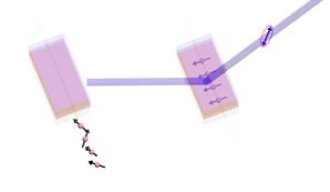Nov. 28, 2017 Research Highlight Physics / Astronomy
Spins line up for data duty
Electric fields produced by structural mismatches between two materials could be harnessed to manage data in spintronic devices
 Figure 1: In the Rashba−Edelstein effect, the electric field between two materials orients electrons’ spins (indicated by black arrows) in the same direction. Light reflected from the sample is then polarized by the accumulated spins (right). © 2017 RIKEN Center for Emergent Matter Science
Figure 1: In the Rashba−Edelstein effect, the electric field between two materials orients electrons’ spins (indicated by black arrows) in the same direction. Light reflected from the sample is then polarized by the accumulated spins (right). © 2017 RIKEN Center for Emergent Matter Science
The electric field generated at the interface of two materials can marshal electrons so that their spins point in the same direction, researchers at RIKEN have shown experimentally for the first time1. This finding could help to develop new devices in the burgeoning field of spintronics, which uses electron spin rather than electron charge to encode and manipulate data.
Spin imparts electrons with an intrinsic magnetism so that they act like tiny bar magnets. The direction of their spins can be altered at the interface between an oxide with a low hole conductivity and a non-magnetic metal, where the mismatch between the atomic structures of the two materials generates an electric field. Electrons moving through this field experience a magnetic field at right angles to the electric field, which aligns the electrons’ spins so that they point in the same direction, creating what is known as spin accumulation.
Jorge Puebla of the RIKEN Center for Emergent Matter Science and his colleagues have now measured this phenomenon, known as the Rashba−Edelstein effect, at the interface between the insulator bismuth oxide and the non-magnetic metals copper and silver.
While passing an electric current along the interface, the researchers looked for spin accumulation by taking spectroscopy measurements using laser light. Since blue laser light reflected off the sample was polarized by an excess of one type of spin at the interface, measuring the polarization of the reflected laser beam revealed the amount and direction of spin accumulation (see movie).
By performing these measurements at five positions on the interface, the researchers confirmed theoretical predictions that the spin accumulation was evenly distributed across the interface. “Our experiments directly confirm this hypothesis for the first time at nonmagnetic interfaces,” says Puebla.
They also found that the copper and silver samples accumulated spins that pointed in opposite directions. “The orientation of the spins directly relates to the direction of the electric field produced at the interface,” explains Puebla. The team is now working to understand why this difference arises.
One potential application of the direct Rashba−Edelstein effect is in spin-filter devices. These allow certain spin orientations to pass through while blocking others, which could be used to read digital spintronic signals. The effect could also be used to switch a material’s magnetization on the nanometer scale, forming the basis of a data storage device.
The team is now studying spin accumulation in other materials at a range of temperatures and is also exploring whether the inverse Rashba−Edelstein effect can be used to enhance the performance of solar cells.
Related contents
- Metal−oxide interfaces create a flipping point
- Moving forward, spin goes sideways
- Spin currents: pure and clean
References
- 1. Puebla, J., Auvray, F., Xu, M., Rana, B., Albouy, A., Tsai, H., Kondou, K., Tatara, G. & Otani, Y. Direct optical observation of spin accumulation at nonmagnetic metal/oxide interface. Applied Physics Letters 111, 092402 (2017). doi: 10.1063/1.4990113
